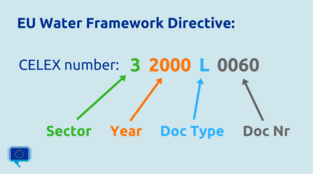EUR-Lex

EUR-Lex is an official website of European Union law and other public documents of the European Union (EU), published in 24 official languages of the EU. The Official Journal (OJ) of the European Union is also published on EUR-Lex. Users can access EUR-Lex free of charge and also register for a free account, which offers extra features.
History
Data processing of legal texts at the European Commission started way back in the 1960s, still using punch cards at the time. A system was being developed to capture relationships between documents and analyse them to extract and re-use metadata,[1] but also to make retrieval easier.
Through the years, the system and its scope grew as the Commission started collaborating with other institutions of the European Union and as the Union started expanding. It was named CELEX (Communitatis Europae Lex) and soon became a well-used interinstitutional tool.
While initially used only internally, the system went through various degrees of availability to the public, including offering content under commercial licences via private companies. Finally, in 1997 a web version was launched and named EUR-Lex, hosted by the Publications Office of the European Union.
The EUR-Lex website was opened to the public in 2001, while CELEX still existed as a separate database until the end of 2004. Subsequently steps were undertaken to merge the two services and to make them completely free of charge.
With the accession of new countries to the European Union and advancements in web and data-processing technologies, the system needed to be improved. A new version was launched in 2004. In 2014 the website saw another major overhaul, including a new database called "CELLAR".[2]
"CELLAR" stores in a single place all metadata and digital content managed by the Publications Office in a harmonized and standardized way.[3]
Content
On EUR-Lex users can access documents in the official EU languages. Language coverage depends on the date of the accession of a country to the EU. All EU law in force on the date of the accession of a new Member State is available in the language of the acceding country as are all documents adopted after this date. Documents repealed or expired before the date of accession are not available in the language of the acceding country.
Only key legislation adopted jointly by the European Parliament and the Council is available in the Irish language, on a transitional basis.[4][5]
While each document (and each language version) is an individual part of the database, the content is grouped into sectors. There are currently 12 sectors, each represented by a number or a letter:[6]
| 1 - Treaties | 2 – International agreements | 3 – Legislation | 4 – Complementary legislation |
| 5 – Preparatory acts | 6 – Case-law | 7 – National implementing measures | 8 – References to national case-law concerning EU law |
| 9 – Parliamentary questions | 0 – Consolidated legislation | C – Other documents published in the Official Journal C series | E – EFTA documents |
Official Journal of the European Union
In 1998 the Official Journal of the European Union (OJ) started being published online, on EUR-Lex. As of 1 July 2013, the digital version of the Official Journal bears legal value instead of the paper version, which is now printed on demand only. The e-OJ has an advanced electronic signature which guarantees its authenticity, integrity and inalterability.[7]
All the editions of the OJ are available on EUR-Lex, dating back to 1952, when they were available in French, Italian, Dutch and German. They can be easily retrieved via a search or by browsing.
EU law
EUR-Lex contains all EU law (sectors 3 and 4), which can be retrieved by browsing or using the search options. The main types of acts under this heading are EU treaties (sector 1), directives, regulations, decisions as well as consolidated legislation (sector 0), etc. Consolidation is the integration of a basic legal act and all of its successive amendments and corrigenda into one easy-to-read document. Consolidated texts are intended for use as reference and have no legal value.[8]
Acts which require transposition are published with a list of links to information about the national implementing measures (sector 7).
Preparatory acts and legislative procedures
The database contains also documents preceding legal acts, such as legislative proposals, reports, green and white papers, etc. (sector 5). It should be noted that some proposals never make it past the preparatory stage, but are still available for consultation.
Each legislative procedure is presented in EUR-Lex with a timeline and a list of events and pertaining documents. Procedures can be accessed via the search or from one of the procedure documents.
EU case law
These documents, authored by the Court of Justice of the European Union, form sector 6 and include, inter alia, judgments, orders, rulings and opinions of the Advocates General.
Other documents
EUR-Lex stores also international agreements (sector 2), parliamentary questions (sector 9), EFTA acts, which include also acts by the EFTA Court and by the EFTA Surveillance Authority (sector E); judgments delivered by courts in contracting states and the EU Court of Justice under the Brussels Regime;[9] references to national case law concerning EU law (sector 8) and other public documents.
CELEX number and other identifiers

Celex number
While EU documents are numbered in different ways, each of them is assigned a unique, language independent identifier, a CELEX number.
This identifier is composed of the number of the sector, then 4 digits for the year, then one or two letters for the type of document and finally 2-4 digits for the number of the document.[10] For example, the CELEX number of the Waste Electrical and Electronic Equipment Directive is 32012L0019 (3 is the sector, legislation; 2012 is the year of publication in the OJ; L represents EU directives and 0019 is the number under which the directives was published in the OJ).
ECLI
The European Case Law Identifier (ECLI) was introduced by the Council, which concluded that for "identification of judicial decisions a standard identifier should be used which is recognisable, readable and understandable by both humans and computers".[11] Documents can be retrieved using ECLI also on EUR-Lex.
ELI
EUR-Lex offers also the possibility to retrieve documents by their European Legislation Identifier introduced with Council Conclusions of 10 October 2012 (2012/C 325/02).[12]
Functionalities
Search
Documents can be retrieved via a search engine (IDOL[13] by HP Autonomy) using various search forms. It is possible to search by document references, dates, text and a multitude of metadata. Registered users have the option of using the expert search and performing searches using Boolean operators.
Text display and formats
Texts and their metadata can be retrieved, displayed and downloaded in various formats (html, pdf, xml). For simultaneous work with several language versions, users can use the multilingual display, which is especially useful for translation and linguistics .
Reuse of data
The data is available for reuse via a web service for commercial or non-commercial purposes as long as the source is acknowledged.[14] Certain collections (datasets) of documents found on EUR-Lex can also be found on the European Open Data Portal.
Saved documents and searches
Registered users can save documents and searches in their EUR-Lex account, create search and print profiles, and set their own RSS feeds based on saved searches.[15]
Preferences
Registered users have access to a plethora of settings with which they can customise their experience on the website.
| Functionality | Non-registered users | Registered users |
| Simple and advanced search | YES | YES |
| Expert search (Boolean operators, more options) | NO | YES |
| Saved documents and searches | NO | YES
(stored in the account) |
| Website, search, export and print preferences | NO | YES |
| RSS feeds | YES
(only predefined) |
YES
(custom made based on saved searches) |
Access to national law of EU member states
N-Lex is a common access point to national law of each country of European Union. It is an interface between users and databases of national legislation.
See also
References
- ↑ "25 years of European law online". Publications office of the European Union. Retrieved 23 August 2016.
- ↑ "CELLAR, OPEN DATA, LINKED OPEN DATA EU Open Data Portal - presentation" (PDF). Retrieved 23 August 2016.
- ↑ "Common Access to EU Information based on semantic technology (presentation)" (PDF). Retrieved 19 August 2016.
- ↑ "Council Regulation (EC) No 920/2005". Retrieved 18 August 2016.
- ↑ "Council Regulation (EU) No 1257/2010". Retrieved 18 August 2016.
- ↑ "EUR-Lex - Frequently asked questions". Retrieved 18 August 2016.
- ↑ "About the electronic edition of the Official Journal". Retrieved 18 August 2016.
- ↑ "About consolidation". Retrieved 19 August 2016.
- ↑ "JURE – Jurisdiction, recognition and enforcement of judgments in civil and commercial matters". Retrieved 18 August 2016.
- ↑ "EUR-Lex - Frequently asked questions". Retrieved 18 August 2016.
- ↑ "Council conclusions inviting the introduction of the European Case Law Identifier (ECLI) and a minimum set of uniform metadata for case law". 29 April 2011. Retrieved 24 August 2016.
- ↑ "Council conclusions inviting the introduction of the European Legislation Identifier (ELI)". 26 October 2012. Retrieved 24 August 2016.
- ↑ "Access to legislation in force: a question of democracy. A view from an European Union Region: Catalonia. (presentation)" (PDF). Retrieved 18 August 2016.
- ↑ "EUR-Lex - Legal notice". Retrieved 18 August 2016.
- ↑ "EUR-Lex - Help pages". Retrieved 18 August 2016.
External links
- The EUR-Lex website
- Official Journal of the European Union
- Types of documents in EUR-Lex
- N-Lex on EUR-Lex